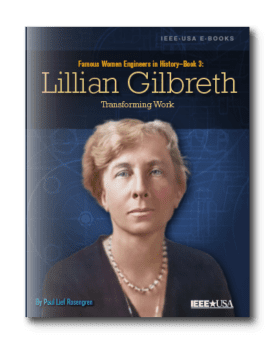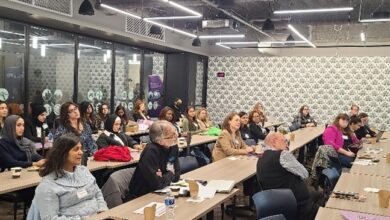

Famous Women in Engineering History – Book 3: Lillian Gilbreth: Transforming Work
FREE to IEEE Members
Non-Members: $2.99
At some point during your day today, Lillian Gilbreth probably will impact your life. It may be when you take a coffee break, or maybe you will be in surgery and the Doctor is handed an instrument by a nurse, or perhaps you will simply throw something out in the kitchen. Gilbreth’s influence in the workplace and in the home is hard to overstate. And yet, she may be best known for the books and movies written about her family: Cheaper by the Dozen (released in 1950 — not the one with Steve Martin) and With Bells on Their Toes (released in 1952).
The new IEEE-USA e-book highlights how Gilbreth expanded the acceptance of Scientific Management (increasing consistency and efficiency in the workplace), introduced human aspects into this nascent field, and applied these principals to the work of women in the home. It chronicles how Gilbreth overcame the death of her husband and business partner and expanded their consulting business by focusing on issues of concern to women. She worked closely with business giants like Thomas Watson (of IBM) and Robert Woods Johnson (of Johnson and Johnson) and served every U.S. President from Herbert Hoover to LBJ.
Gilbreth faced opposition from her family for going to college; was refused enrollment in a course at Columbia by a professor (because he would not teach women); was barred from a men’s engineering lecture; lost clients after the death of her husband (they were worried it would look bad to be told how to run their business by a woman); and was left off as author for several books she co-wrote (later, they would include just her initials — to hide her gender).
Despite all of these challenges, she excelled in her field. Gilbreth was the first woman to speak at a University of California graduation (as valedictorian at Berkeley); wrote numerous books (eventually under her own name); served as the President of the American Association of University Women (AAUW); and between 1928 and 1964, received 23 honorary degrees. In 1926, she became the second woman to become a member of the American Society of Mechanical Engineers (ASME); and later, would become member #1 of the Society of Women Engineers.
Frank and Lillian Gilbreth believed that there was “one best way” to do any task; and they set out eagerly using stopwatches, specially designed timers, and filming workers to uncover it. Lillian’s focus on worker satisfaction through better benefits, lighting and work breaks separated the Gilbreths from others — and grew out of Lillian’s education in psychology; and her view that any analysis needed a human dimension.
After her husband’s death, Lillian built back the business and establish a national, and increasingly international, name on her own.
For a project for GE, Gilbreth interviewed 4,000 women to design the perfect height for stoves; and she developed the optimal distance between appliances — still influencing kitchen design today. Gilbreth suggested adding shelves to the inside of refrigerator doors, and incorporating a pedal on kitchen garbage cans (so they could be opened when a woman’s hands were full of dishes).
She taught her principles to hundreds of home economic teachers; and she ran courses in her home for corporate executives from around the world. Some of her students would go on to develop the Toyota System of Production and revolutionize the way Japanese companies were run after WWII.
Gilbreth was the first woman elected to the National Academy of Engineers; and she was honored in 1984 with a U.S. postage stamp.
You can learn more about Lillian Gilbreth in the IEEE-USA e-book Lillian Gilbreth: Transforming Work free for all IEEE members at the IEEE-USA Shop; non-members pay $2.99. You might also direct young researchers to the first two e-books in the Famous Women Engineers in History series: Edith Clarke: Trailblazer in Electric Engineering and Hedy Lemarr, Inventor Extraordinaire and Hollywood Star.






